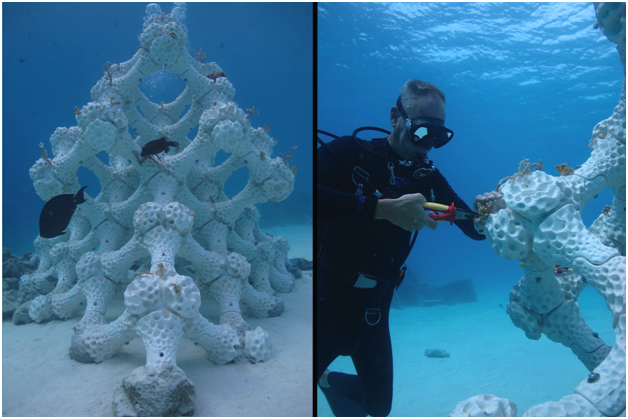Preliminary Research and Documentation
The following research and documentation is meant to get this project started. Please consider this a work in progress. Significant work is needed to move this project forward.
RequirementsSoftware Specifications
Structure and Material- Natural corals are made of calcium carbonate (limestone). We need to investigate if we can print using calcium carbonate and other materials that are are sturdy and eco-friendly.The
structurefollowingmustsectionsbe sturdy enough to withstand underwater currents and impact by big fish. The coloring must look natural.Insidedescribe thestructure-specificationsTheforstructureHomeneedsGesturetoControlhave chambers or crevices that fish can use to hide from predators. Or make it their home. Fish love that. When designing the structure, we need to ensure that there is enough natural lighting in the crevices. Also we need to investigate if we can add artificial lighting and maybe even a camera to study polyps and other marine life.Rooting the structure- Natural corals tend to grow roots and grow into the in the ocean bed. The 3D printed coral must have a rooting structure that can be drilled into the ocean floor. This will make the overall structure sturdy enough to withstand under water currents and impact by big fish.
Figure 3 - Coral reef installationsystem.
References
Computer vision
InCameras 1997placed at strategic locations in the firstseapod Sayaidentify de Malha expedition was conducted by Wolf Hilbertz, Thomas Goreau, Kai Hilbertzresidents and Carolinevalidate Mekie.their Dueauthenticity. AI and ML track actions, movements and gestures. Once authenticated, the cameras look for specific actions and gestures to execute commands.
The cameras are installed at specific locations and the software controls the specific action in that area. For example, a camera installed above a door can control actions of that door. A camera installed in the shower controls the water flow and temperature only.
Input Gestures
The software application has default gestures built-in for basic functions. Residents can change the defaults and add their own customized gestures and define the output.
Default Gestures
The following basic gestures are built in to the distancesystem:
Lights
- Wave - to turn on or turn off home gesture control system
- Index finger pointed up - Turn on lights
- Index finger pointed down - Turn off lights
- Fist to spread all fingers apart - increase brightness of light
- All fingers apart to fist - decrease brightness of light.
Door and costWindows
- Wave
there,-onlyto1.5 days could be spentturn onsiteoronturntheoffNorthhomeBank.gestureSeveralcontroldivessystem - Spread
conducted,handsaboutapart1.5-hoursOpenofwindowunderwaterorvideodoor - Bring
takenhandsdocumentingtogetherthe-faunaClose
Surprisingly these reefs were not dominated by any one group of corals, as is typical of most Indian Ocean reefs. Instead the coral populations consisted of small numbers of many different groups of corals, widely distributed. The larger corals were mostly rounded heads of Porites, or clumps of columnar Heliopora or Millepora, with smaller corals of many kinds around them. Many corals were observed to be loosely attached to the bottom, and many were being attacked by boring sponges, by several distinct coral diseases, or had algae overgrowing their edges.
Detailed information is available in the Saya de Malha Expedition (2002) report.
Also See
Dr. David Vaughan at the Mote Laboratory is growing coral 40 times faster than in the wild. The lab takes a coral that is about as big as a golf ball and cut it into 20 to 100 micro-fragments. Each fragment grows back in a few months. Detailed information and links are available in the Micro-Fragmenting report.

